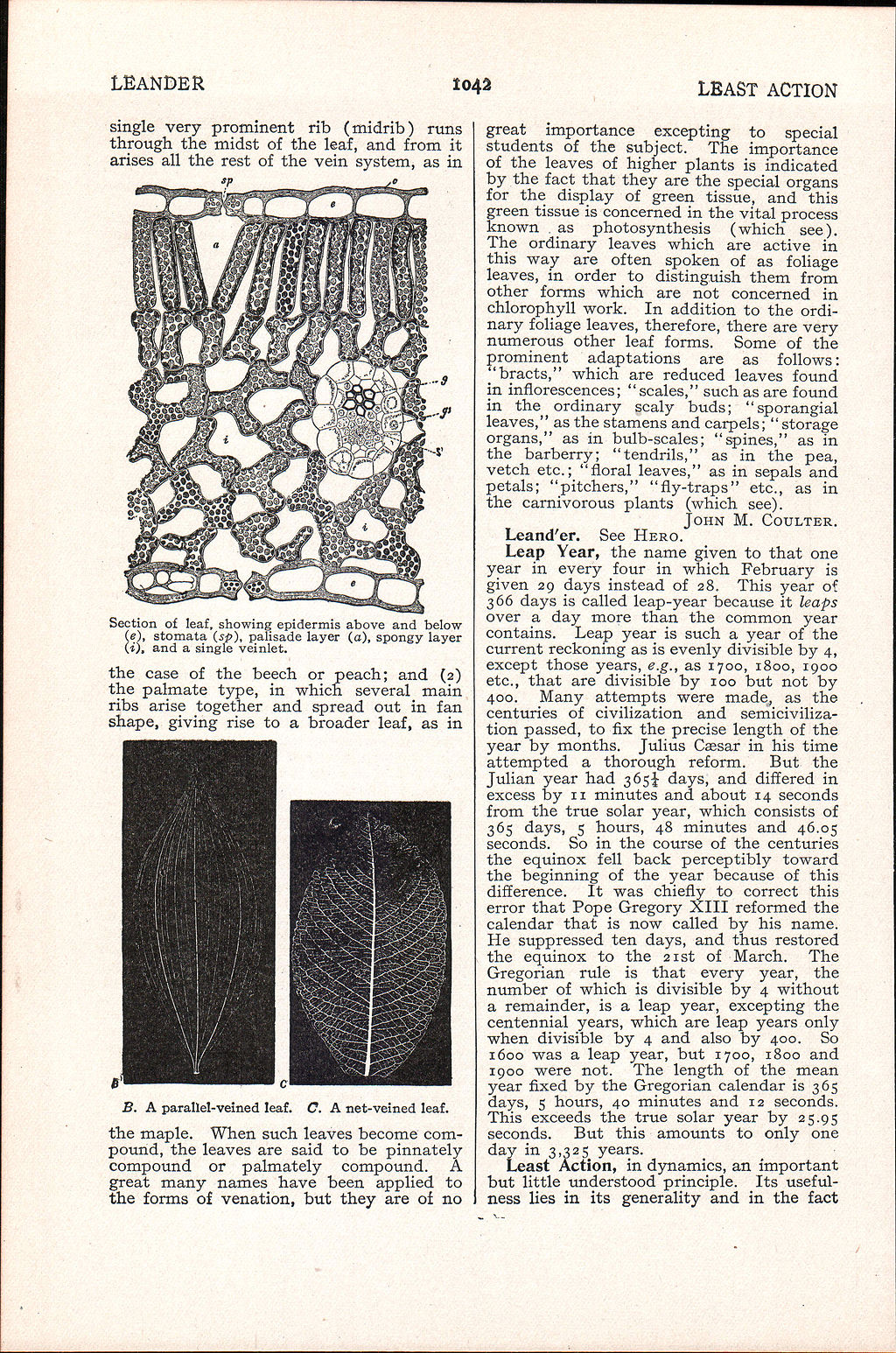LEANDER
1042
LEAST ACTION
single very prominent rib (midrib) runs through the midst of the leaf, and from it arises all the rest of the vein system, as in
Section of leaf, showing epidermis above and below (*), stomata (sp), palisade layer (a), spongy layer (i), and a single veinlet.
the case of the beech or peach; and (2) the palmate type, in which several main ribs arise together and spread out in fan shape, giving rise to a broader leaf, as in
B. A parallel-veined leaf. C. A net-veined leaf.
the maple. When such leaves become compound, the leaves are said to be pinnately compound or palmately compound. A great many names have been applied to the forms of venation, but they are of no
great importance excepting to special students of the subject. The importance of the leaves of higher plants is indicated by the fact that they are the special organs for the display of green tissue, and this green tissue is concerned in the vital process known as photosynthesis (which see). The ordinary leaves which are active in this way are often spoken of as foliage leaves, in order to distinguish them from other forms which are not concerned in chlorophyll work. In addition to the ordinary foliage leaves, therefore, there are very numerous other leaf forms. Some of the prominent adaptations are as follows: "bracts," which are reduced leaves found in inflorescences; "scales," such as are found in the ordinary scaly buds; "sporangial leaves," as the stamens and carpels; " storage organs," as in bulb-scales; "spines," as in the barberry; "tendrils," as in the pea, vetch etc.; "floral leaves," as in sepals and petals; "pitchers," "fly-traps" etc., as in the carnivorous plants (which see).
JOHN M. COULTER.
Leand'er. See HERO.
Leap Year, the name given to that one year in every four in which February is given 29 days instead of 28, This year of 366 days is called leap-year because it leaps over a day more than the common year contains. Leap year is such a year of the current reckoning as is evenly divisible by 4, except those years, e.g., as 1700, 1800, 1900 etc., that are divisible by 100 but not by 400. Many attempts were made, as the centuries of civilization and semiciviliza-tion passed, to fix the precise length of the year by months. Julius Caesar in his time attempted a thorough reform. But the Julian year had 365^ days, and differed in excess by n minutes and about 14 seconds from the true solar year, which consists of 365 days, 5 hours, 48 minutes and 46.05 seconds. So in the course of the centuries the equinox fell back perceptibly toward the beginning of the year because of this difference. It was chiefly to correct this error that Pope Gregory XIII reformed the calendar that is now called by his name. He suppressed ten days, and thus restored the equinox to the 2ist of March. The Gregorian rule is that every year, the number of which is divisible by 4 without a remainder, is a leap year, excepting the centennial years, which are leap years only when divisible by 4 and also by 400. So 1600 was a leap year, but 1700, 1800 and 1900 were not. The length of the mean year fixed by the Gregorian calendar is 365 days, 5 hours, 40 minutes and 12 seconds. This exceeds the true solar year by 25.95 seconds. But this amounts to only one day in 3,325 years.
Least Action, in dynamics, an important but little understood principle. Its usefulness lies in its generality and in the fact
